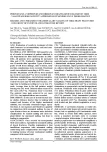Reamed and Unreamed Intramedullary Nailing of Tibia Shaft Fractures - our Group of Patients and Literature Review
Authors:
Jan Trlica; Tomáš Dědek; Ivan Počepcov; Jan Folvarský; Jan Zahradníček; Ivo Žvák; Tomáš Holeček; Jaromír Kočí; Karel Šmejkal
Authors‘ workplace:
Surgery Department, University Hospital Hradec Králové
; Chirurgická klinika Fakultní nemocnice Hradec Králové
Published in:
Úraz chir. 16., 2008, č.3
Overview
Aim:
Evaluation of results in treatment of tibia shaft fractures by intramedullary nail and comparison with other authors.
Material and method:
Retrospective study of results in treatment of patient admitted to our department for tibia shaft fracture in 2002– 2004. All patients were operating by unreamed tibia nail (UTN, Synthes®). Minimal follow-up was 12 months after operation. Types of fracture, grade of soft tissue damage, time to union, early and late complications were recorded. Functional result was evaluated according to IOWA score.
Results:
48 patients of 108 (45 %) were checked up. In three cases (6,25 %) were recorded non - infectious complications. Any infectious complication was recorded. Compartment syndrome occurred in two cases (4,2 %) with close fracture. Average time to healing according to X-ray was 17,1 week. Average time to the full painless weight bearing was 24,1 week. Delayed union occurred in five cases (10,5 %). Nonunion wasn’t recorded. The anterior knee pain occurred in sex cases (12,5 %). Any implant failure was recorded.
Discussion:
In the case of closed fracture many studies evidence shorter time to healing with reamed nail because of his higher mechanical stability, but currently document longer operation time, X-ray exposure and blood loss quantity in comparison with unreamed nailing. In case of open fracture there are document more infection complications by reamed nailing and more implant failure by unreamed nailing, but time to healing is comparable.
Conclusion:
Ours records uncorresponded with some authors, especially in unreamed nailing of closed fractures. Possible explanation is that insufficient experience with unreamed nailing could bring more complications and longer time to healing because of lower mechanical stability compared with reamed nail.
Key words:
fracture, tibia, shaft, nail
Sources
1. ANGLEN, J.O., BLUE, J.M. A comparison of reamed and unreamed nailing of the tibia. J Trauma. 1995, 39, 351–355.
2. BHANDARI, M., GUYATT, G.H. SWIONTKOW-SKI, M.F. et al. Treatment of open fractures of the shaft of the tibia. J Bone Joint Surg. 2001, 83-Br, 62–68.
3. BHANDARI, M. GUYATT, G.H. TONG, D. et al. Reamed versus nonreamed intramedullary nailing of lower extremity long bone fractures: a systematic overview and metaanalysis. J Orthop Trauma. 2000, 14, 2–9.
4. BHANDARI, M. SWIONTKOWKSI, M.F. Re: Should the tibia be reamed when nailing? Injury. 2006, 37, 574–575.
5. CHAPMAN, M.W. The effect of reamed and nonreamed intramedullary nailing on fracture healing. Clin Orthop Relat Res, 1998, 8, S230.
6. COURT-BROWN, C.M. Reamed intramedullary tibial nailing: an overview and analysis of 1106 cases. J Orthop Trauma, 2004,18, 96–101.
7. COURT-BROWN, C.M. GUSTILO, T. SHAW, A.D. Knee pain after intramedullary tibial nailing: its incidence, etiology, and outcome. J Orthop Trauma. 1997, 11, 103–105.
8. FINKEMEIER, C.G. SCHMIDT, A.H. KYLE, R.F. et al. A prospective, randomized study of intramedullary nails inserted with and without reaming for the treatment of open and closed fractures of the tibial shaft. J Orthop Trauma. 2000, 14, 187–193.
9. FINKEMEIER, C.G. SCHMIDT, A.H. KYLE, R.F. et al. A prospective, randomized study of intramedullary nails inserted with and without reaming for the treatment of open and closed fractures of the tibial shaft. J Orthop Trauma. 2000, 14, 187–193.
10. KARUNAKAR, M.A. FRANKENBURG, E.P. LE, T.T. et al. The thermal effects of intramedullary reaming. J Orthop Trauma. 2004, 18: 674–679.
11. KATSOULIS, E. COURT-BROWN, C. GIANNOuDIS, P.V. Incidence and aetiology of anterior knee pain after intramedullary nailing of the femur and tibia. J Bone Joint Surg. 2006, 88-Br, 576–580.
12. KEATING, J.F. BLACHUT, P.A. O'BRIEN, P.J. et al. Reamed nailing of Gustilo gradeIIIB tibial frac-tures. J Bone Joint Surg. 2000, 82-Br, 1113–1116.
13. KEATING, J.F. O'BRIEN, P.J. BLACHUT, P.A. et al. Locking intramedullary nailing with and without reaming for open fractures of the tibial shaft. A prospective, randomized study. J Bone Joint Surg. 1997, 79-Am, 334–341.
14. KLEIN, M.P. RAHN, B.A. FRIGG, R. et al. Reaming versus nonreaming in medullary nailing: interference with cortical circulation of the canine tibia. Arch Orthop Trauma Surg. 1990, 109, 314–316.
15. MERCHANT, T.C., DIETZ, F.R. Long-term follow-up after fractures of the tibial and fibular shafts. J Bone Joint Surg Am, 71: 599-606, 1989.
16. PETRISOR, B.; ANDERSON, S. COURT-BROWN, C.M. Infection after reamed intramedullary nailing of the tibia: a case series review. J Orthop Trauma. 2005, 19, 437–441.
Labels
Surgery Traumatology Trauma surgeryArticle was published in
Trauma Surgery

2008 Issue 3
- Metamizole vs. Tramadol in Postoperative Analgesia
- Metamizole at a Glance and in Practice – Effective Non-Opioid Analgesic for All Ages
- Possibilities of Using Metamizole in the Treatment of Acute Primary Headaches
- Current Insights into the Antispasmodic and Analgesic Effects of Metamizole on the Gastrointestinal Tract
- Spasmolytic Effect of Metamizole
Most read in this issue
- Reamed and Unreamed Intramedullary Nailing of Tibia Shaft Fractures - our Group of Patients and Literature Review
- National Children´s Trauma Register
- Additive stabilisation of the elbow using external fixator in pediatric skeletal traumatology
- ASEPSIS – POINT OF CONSCIENCE AND PROFESSIONALISM
